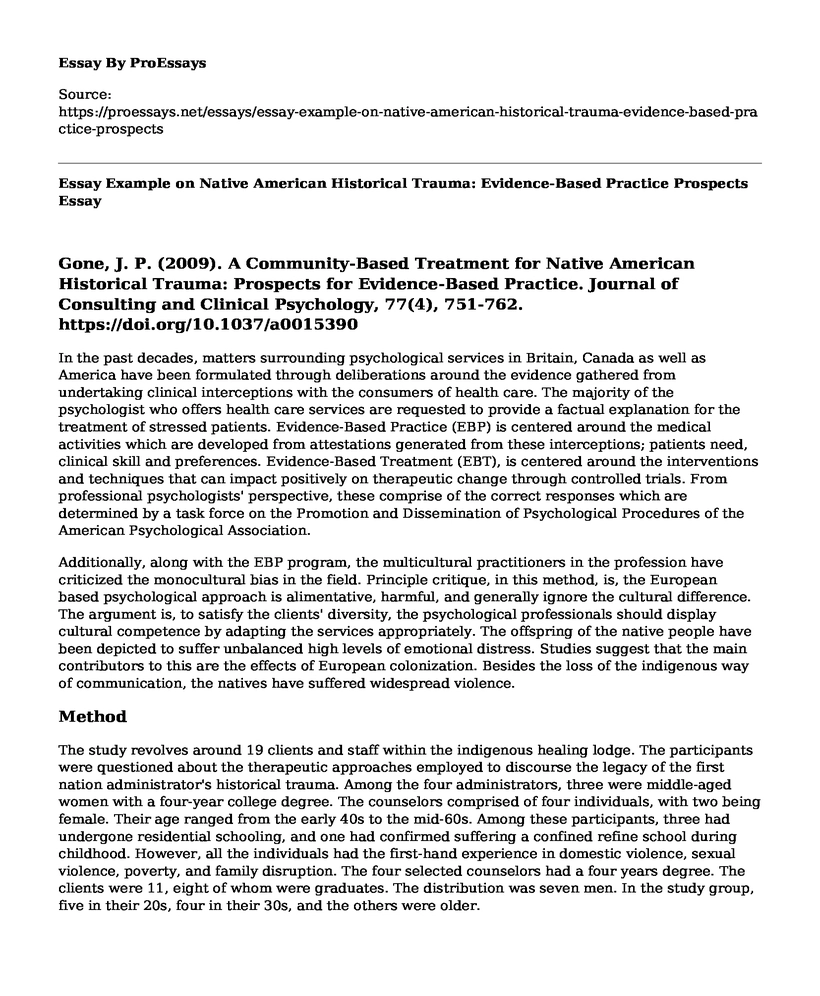Gone, J. P. (2009). A Community-Based Treatment for Native American Historical Trauma: Prospects for Evidence-Based Practice. Journal of Consulting and Clinical Psychology, 77(4), 751-762. https://doi.org/10.1037/a0015390
In the past decades, matters surrounding psychological services in Britain, Canada as well as America have been formulated through deliberations around the evidence gathered from undertaking clinical interceptions with the consumers of health care. The majority of the psychologist who offers health care services are requested to provide a factual explanation for the treatment of stressed patients. Evidence-Based Practice (EBP) is centered around the medical activities which are developed from attestations generated from these interceptions; patients need, clinical skill and preferences. Evidence-Based Treatment (EBT), is centered around the interventions and techniques that can impact positively on therapeutic change through controlled trials. From professional psychologists' perspective, these comprise of the correct responses which are determined by a task force on the Promotion and Dissemination of Psychological Procedures of the American Psychological Association.
Additionally, along with the EBP program, the multicultural practitioners in the profession have criticized the monocultural bias in the field. Principle critique, in this method, is, the European based psychological approach is alimentative, harmful, and generally ignore the cultural difference. The argument is, to satisfy the clients' diversity, the psychological professionals should display cultural competence by adapting the services appropriately. The offspring of the native people have been depicted to suffer unbalanced high levels of emotional distress. Studies suggest that the main contributors to this are the effects of European colonization. Besides the loss of the indigenous way of communication, the natives have suffered widespread violence.
Method
The study revolves around 19 clients and staff within the indigenous healing lodge. The participants were questioned about the therapeutic approaches employed to discourse the legacy of the first nation administrator's historical trauma. Among the four administrators, three were middle-aged women with a four-year college degree. The counselors comprised of four individuals, with two being female. Their age ranged from the early 40s to the mid-60s. Among these participants, three had undergone residential schooling, and one had confirmed suffering a confined refine school during childhood. However, all the individuals had the first-hand experience in domestic violence, sexual violence, poverty, and family disruption. The four selected counselors had a four years degree. The clients were 11, eight of whom were graduates. The distribution was seven men. In the study group, five in their 20s, four in their 30s, and the others were older.
The study used semi-structured open-ended questions to allow flexibility. The interview questions sought to obtain a narrative of the respondents' life experiences before concentrating on additional items. Before conducting this process, all the required approvals were gotten before data collection. The formal interviews were only conducted when every participant could manage to travel to the lodge. All the participants signed consent to participate in the study. The participants have also compensated their travel expenses and awarded a university branded apparel. All the data collected was transcribed by employed assistants and yielded 379 single-spaced pages.
Conclusion
Based on the inferences from the analysis of data, it can be concluded that the majority of the clients live with their childhood pains, and most resulted in temporary solutions like substance abuse. Additionally, to obtain relief, the childhood pain needed to be confessed and confronted. Cathartic expression was deemed to initiate a healing process of lifelong self-reflection and self-development. The reviewed inferences also indicated that the healing process required reclamation of heritage that was severely damaged by the European colonization. One of the significant ways the psychologists can harmonize Evidence-Based and traditionally sensitive treatment is to join with indigenous programs in the study to determine therapeutic results for the existing traditionally sensitive interceptions that respond maximumly to social interests as well as needs.
Reference
Denis. (2019, June 13). Maslow's Hierarchy of Needs. Retrieved from Expert Program Management website: https://expertprogrammanagement.com/2019/06/maslows-hierarchy-of-needs/
Cite this page
Essay Example on Native American Historical Trauma: Evidence-Based Practice Prospects. (2023, Mar 28). Retrieved from https://proessays.net/essays/essay-example-on-native-american-historical-trauma-evidence-based-practice-prospects
If you are the original author of this essay and no longer wish to have it published on the ProEssays website, please click below to request its removal:
- The Temple of Zeus Essay
- Critiquing Colonization of Nature: Buying from Killjoy's "Wardens"
- Abraham Lincoln, Slavery and the American Civil War Essay
- Technology, the Industrial Revolution, and Imperialism Essay
- Current News Story That Relates to the Old Testament - Essay Sample
- Bedford Literature of the American Slave History Before 1865 Essay Example
- Essay Example on Edo Period: Japan's Warrior Culture & Urbanization







